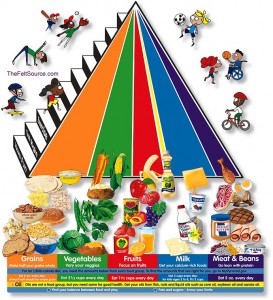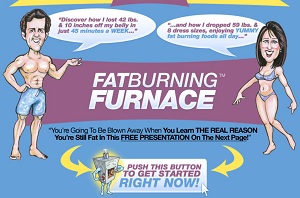Food Pyramid Basics
June 24, 2011 by Guest Author
Filed under Healthy Eating
 For many years, the Food Pyramid has been utilized to attain optimal health and wellness by showing what type (and just how much) of individual foods people should eat every single day. Redesigned in 2005, the updated pyramid features a rainbow of colored, vertical stripes corresponding towards the five major recommended food groups, plus oils and fats.
For many years, the Food Pyramid has been utilized to attain optimal health and wellness by showing what type (and just how much) of individual foods people should eat every single day. Redesigned in 2005, the updated pyramid features a rainbow of colored, vertical stripes corresponding towards the five major recommended food groups, plus oils and fats.
If you’re undecided what the colors stand for, the following can be a quick reference:
Orange – cereals
Green – vegetables
Red – fresh fruits
Yellow – oils and fats
Blue – dairy products for example milk and butter
Purple – beans, nuts, fish and meats
Simply put, the food pyramid is a visual self-help guide to show all the different food people need to eat to help keep a healthy diet. The narrower the color band, the less consumption is required of the kind of food corresponding for it and the opposite way round. As you will observe,it’s always best to eat a a number of healthy food. With the pyramid as your best guide, you must attain to eat food from corresponding to every color band and adopting the proposed proportion on a daily basis.
Noticeably, the modern pyramid has bands of diverse size; they get narrower and thinner when they reach the top. This is really because food products are not made the same. While cherry pie contains cherries, it does not equate to the vitamins and minerals you would get from freshly-picked cherries straight from your tree! The same argument may be used with tomato vs. tomato ketchup. The more nutritious number of food is shown on the bottom thicker area of the pyramid, as the less nutritious appear at the very top.
The most crucial feature of the food pyramid will be the way it illustrates just how much an individual should eat from each food category for each and every day. This is particularly significant when giving proper care about a kid’s nutrition.
Grains: Children should consume 4-6 ounces of grains every day to meet their daily requirements. Whole grains are the best options.
Vegetables: Vegetables play a huge role in a good diet. For the children, the daily requirement is always to consume around ½ to two cups.
Fruits: Fresh fruits provide a significant number of nutrients for a well-balanced diet. Remember that packaged fruits and fruit drinks rely on the slimmer part of the pyramid so it’s always easier to opt for the fresh picks. Children need 1-1 ½ cups of fruits daily.
Dairy Products as well as other Calcium-Rich Foods: It is generally known that calcium builds strong teeth and bones. So it is prudent to consume a helping from it on a daily basis. For kids, a minimum of 1-2 cups of milk (or other calcium-rich food) is necessary to reach the proposed daily requirement.
Beans, Nuts, Seafood and Meat:
Other nutrients like iron and protein needed to stay healthy are located in this category. Kids must consume 3-5 ounces per day.
The Foodstuff Pyramid has produced it a lot easier to lead a nutritious way of living.



